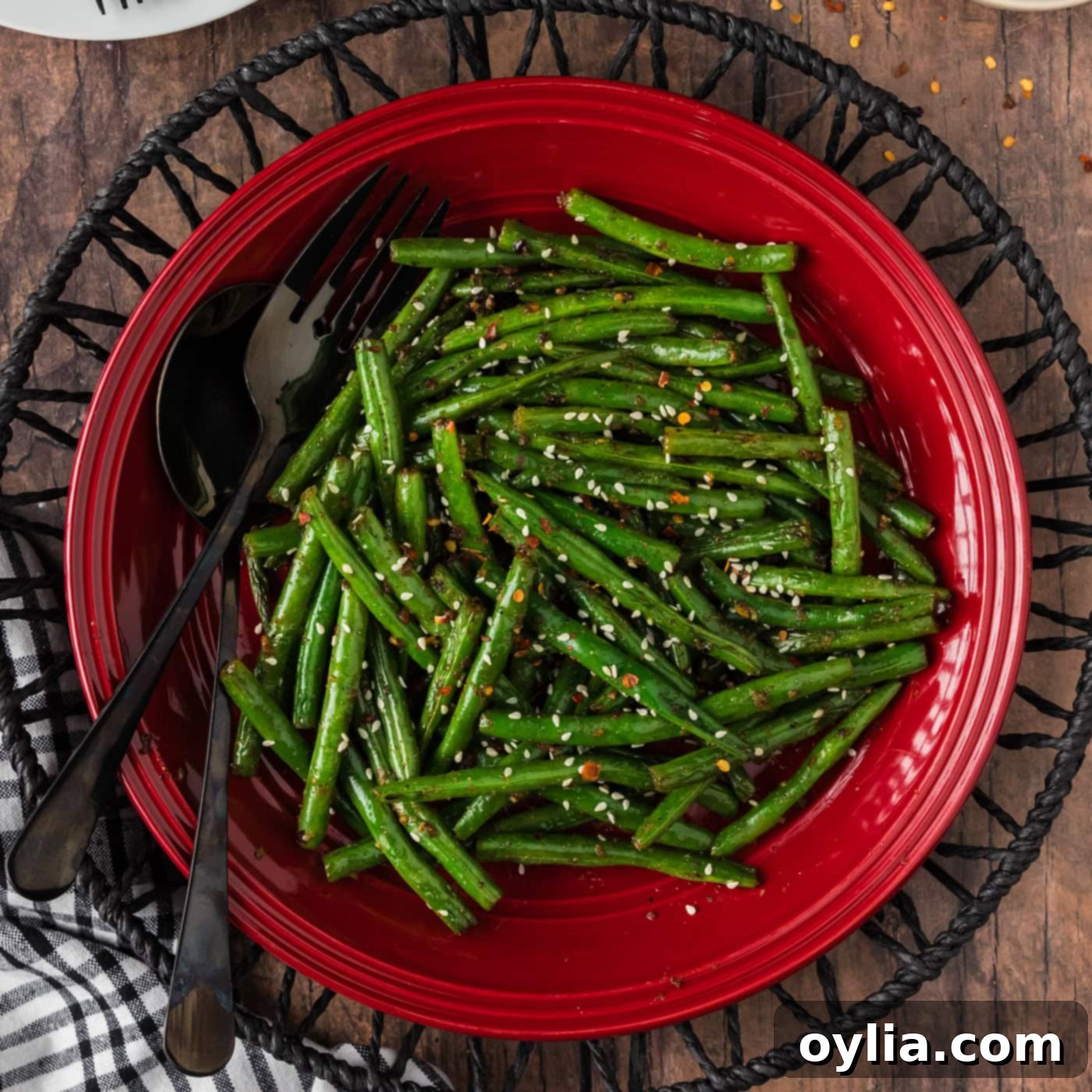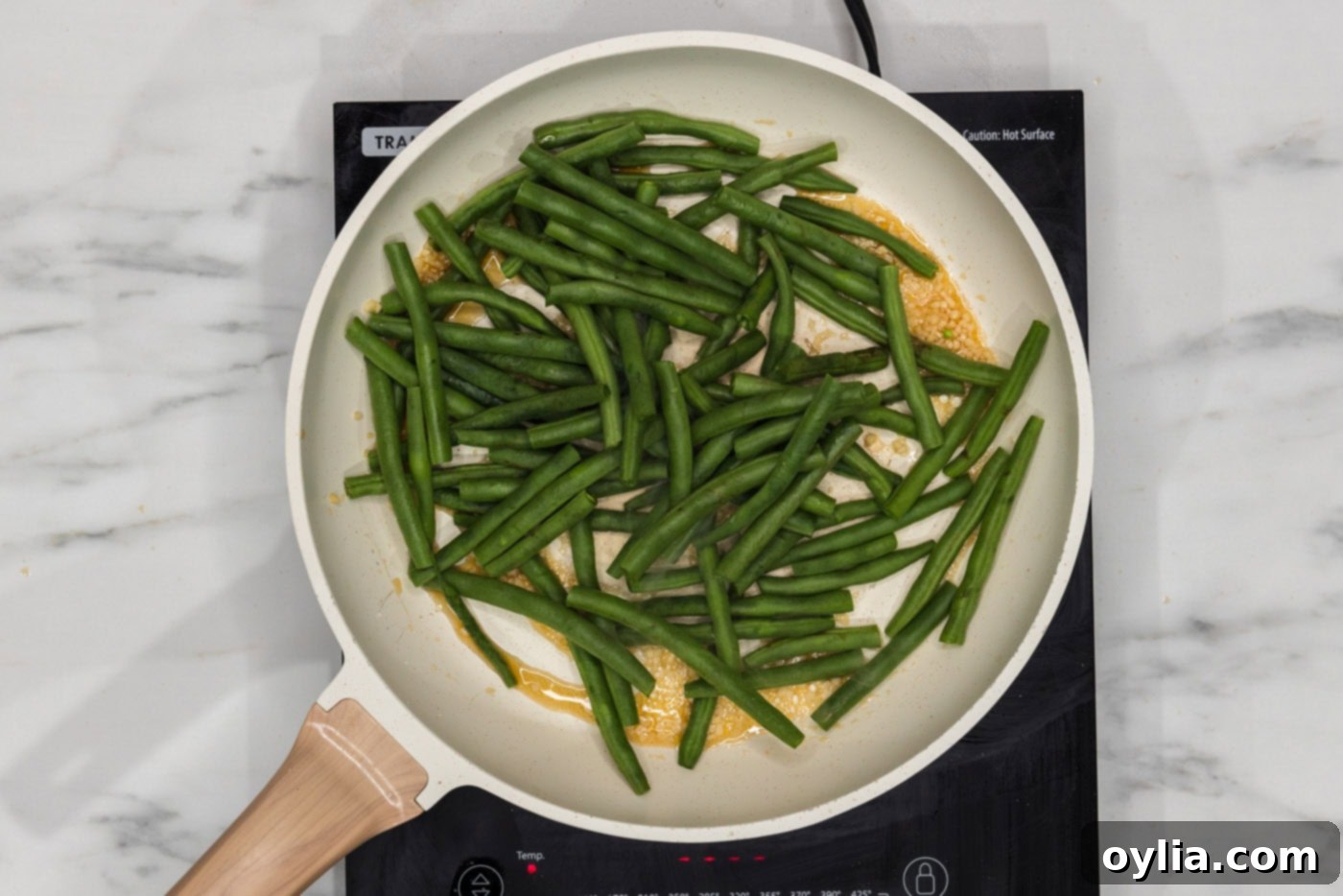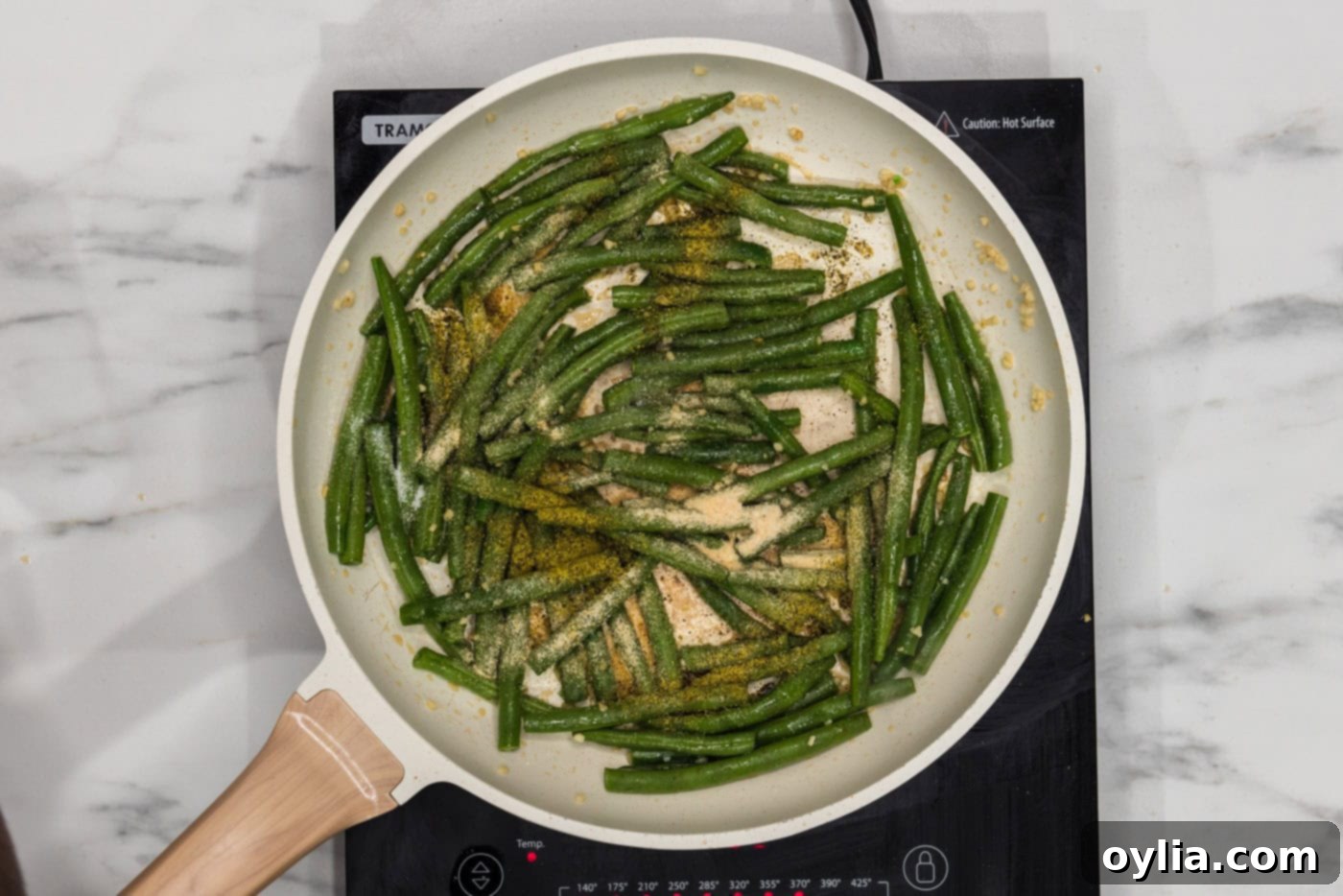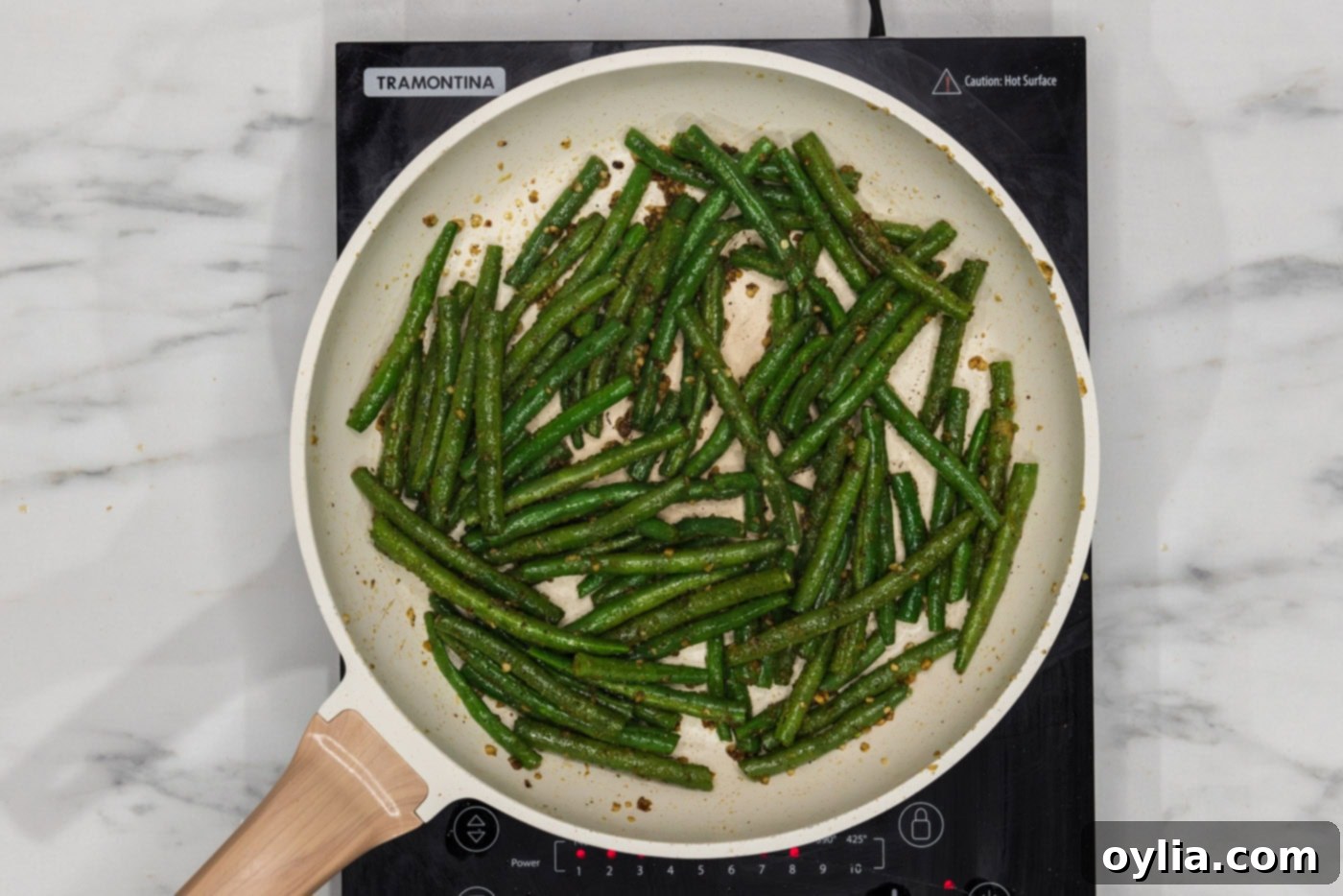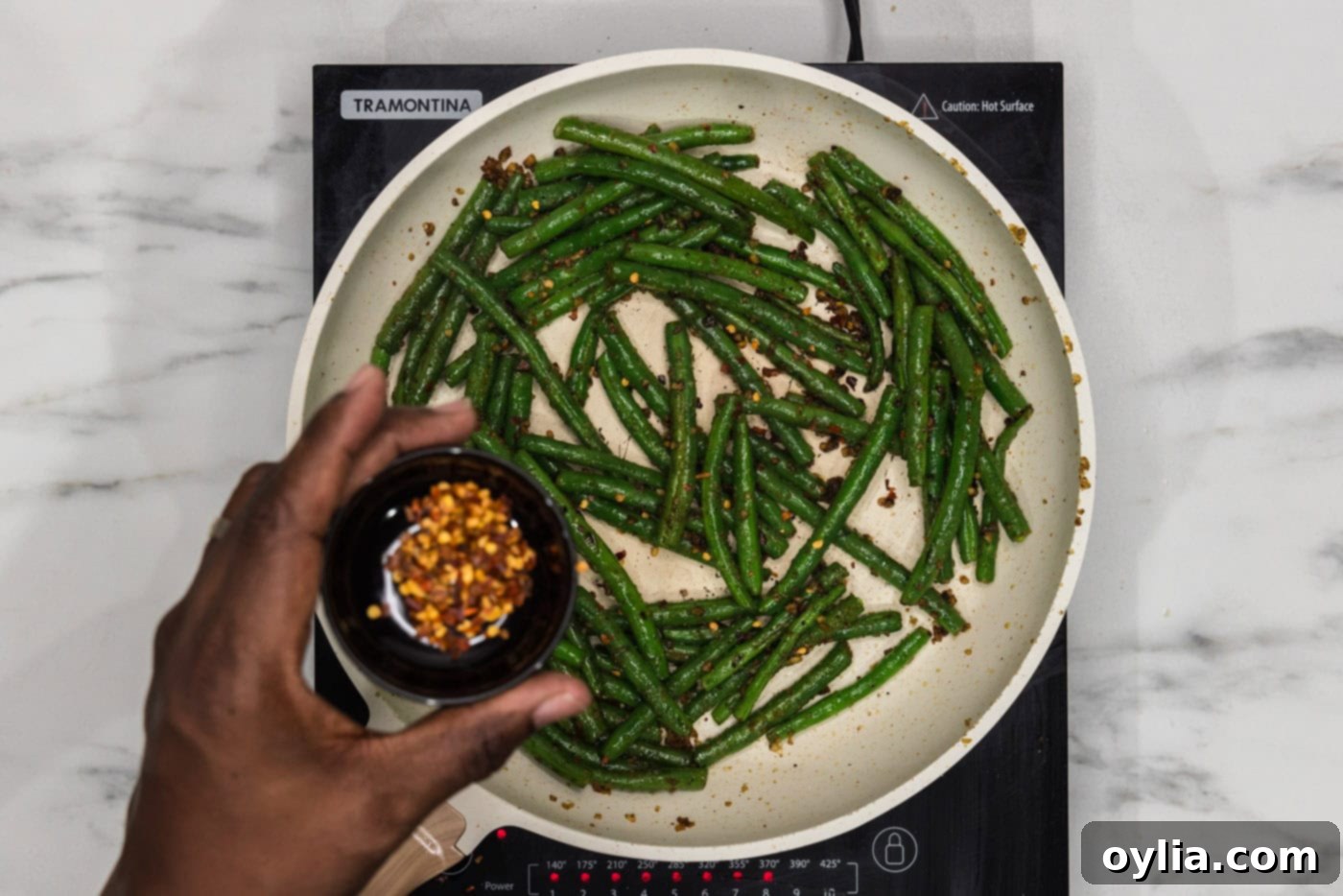Delicious Sauteed Green Beans: Quick, Easy, and Flavorful (No Blanching Required!)
Elevate your everyday meals with a side dish that’s both vibrant and incredibly satisfying: perfectly sautéed green beans. This recipe brings green beans to life, infusing them with the rich, nutty notes of sesame oil, the aromatic punch of fresh garlic, and a balanced medley of seasonings. What makes this recipe truly special is its sheer simplicity and speed – it comes together in just about 20 minutes in a single skillet, without the need for any blanching. Get ready to enjoy a tender-crisp vegetable side that will become a go-to favorite for weeknight dinners and special occasions alike!
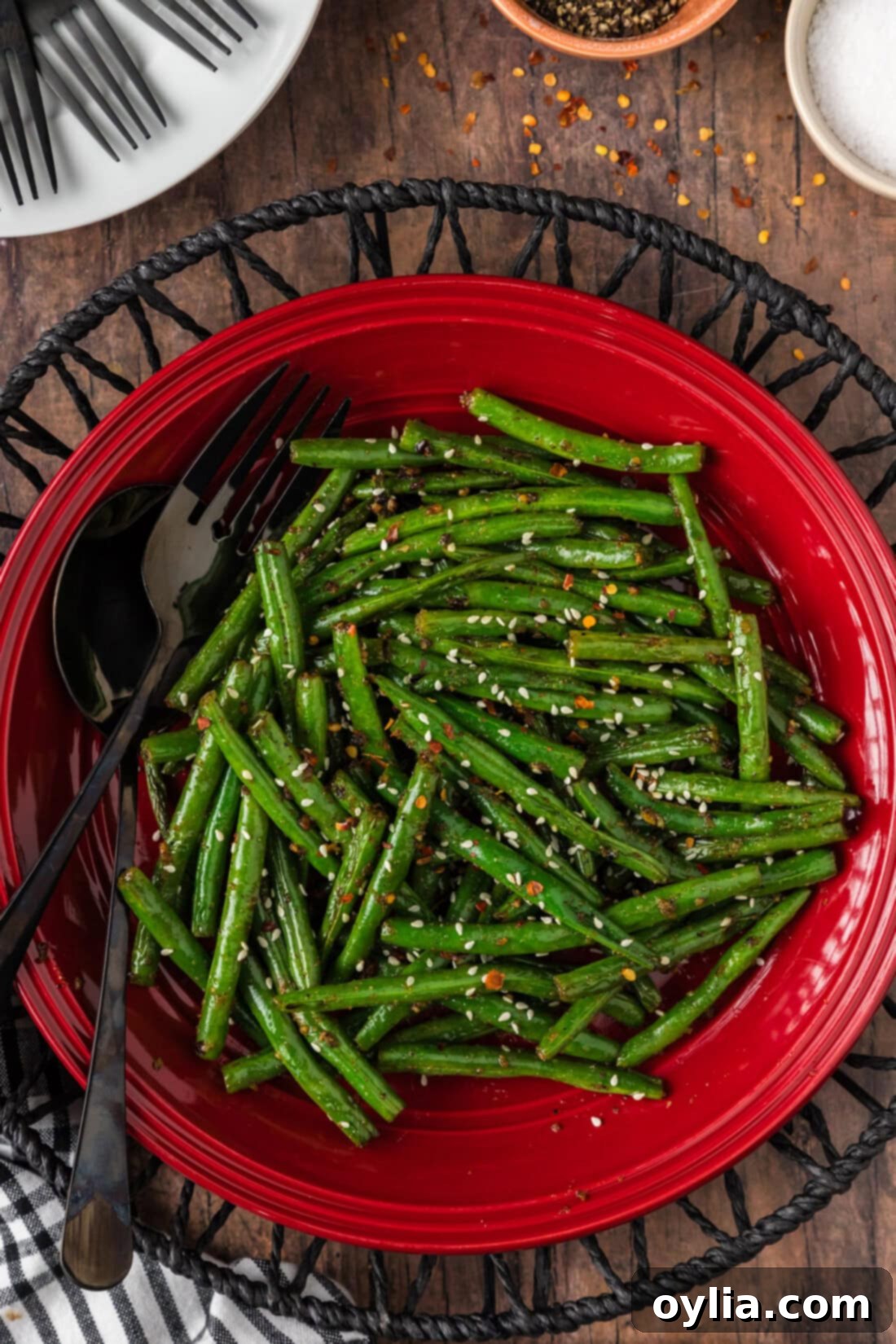
Why This Sautéed Green Bean Recipe Is a Winner
Many recipes for green beans suggest blanching them first – a process involving boiling then shocking the vegetables in ice water – to ensure a vibrant color and tender texture. However, we’re here to tell you that achieving perfectly tender-crisp sautéed green beans is actually incredibly simple, and you can confidently skip that extra step! This recipe champions efficiency without compromising on flavor or texture. All you need is a reliable skillet and about 10 minutes of active cooking time to transform fresh green beans into a delightful side.
The magic happens directly in the pan, where the green beans absorb all the incredible flavors from the fragrant sesame oil and freshly minced garlic. This direct sautéing method not only saves you precious time and reduces cleanup but also allows the beans to develop a slight char and deeper flavor notes that are often lost during blanching. It’s an ideal choice for busy weeknights when you need a quick, healthy side, or when your oven is already occupied with other dishes. Once you try green beans prepared this way, you’ll find yourself reaching for this effortless recipe again and again.
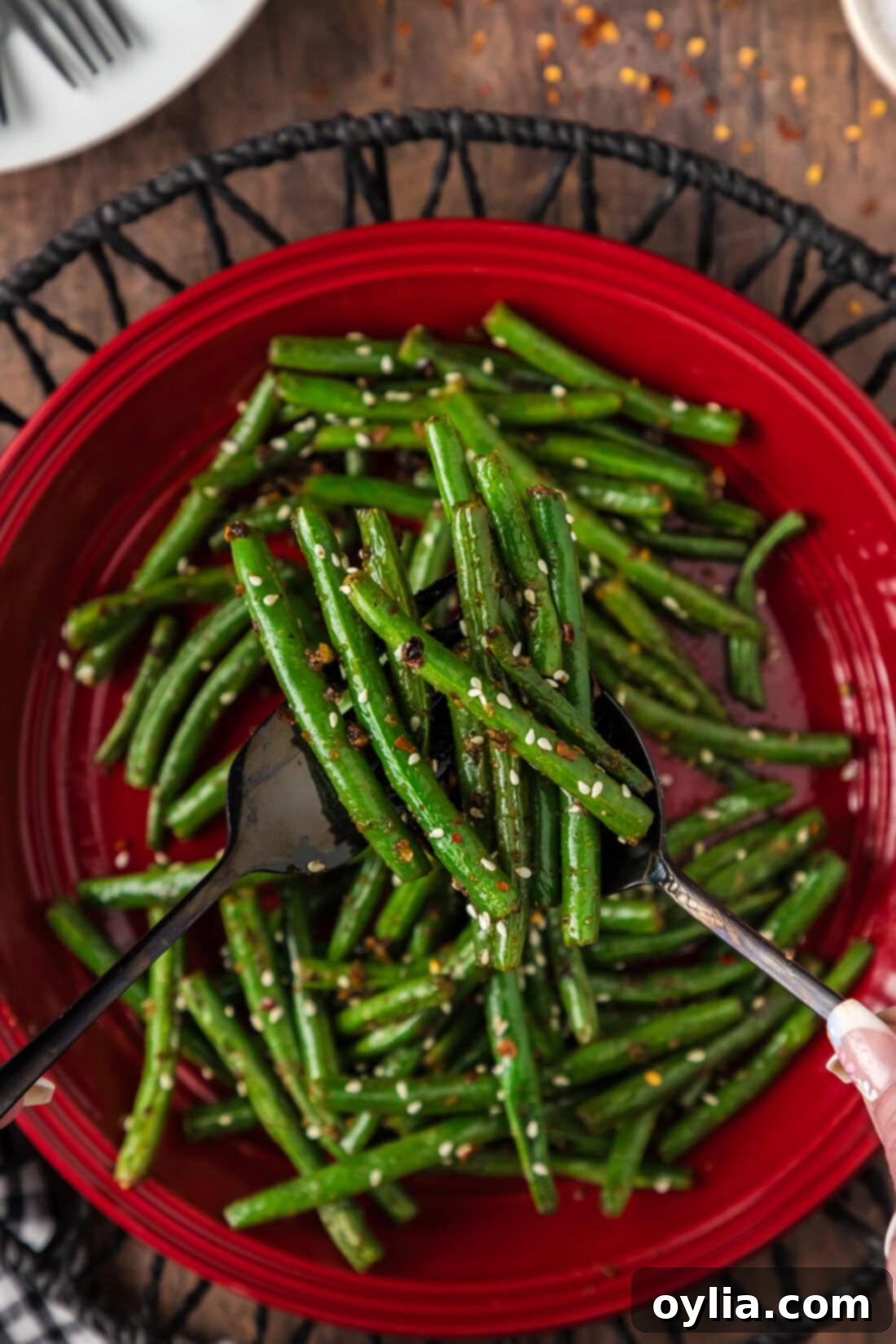
Essential Ingredients for Perfect Skillet Green Beans
Crafting these delectable sautéed green beans requires just a handful of straightforward ingredients, each playing a vital role in building the overall flavor. Below, you’ll find a summary of what you’ll need. For precise measurements and a detailed step-by-step guide, please refer to the complete printable recipe card located at the end of this post.
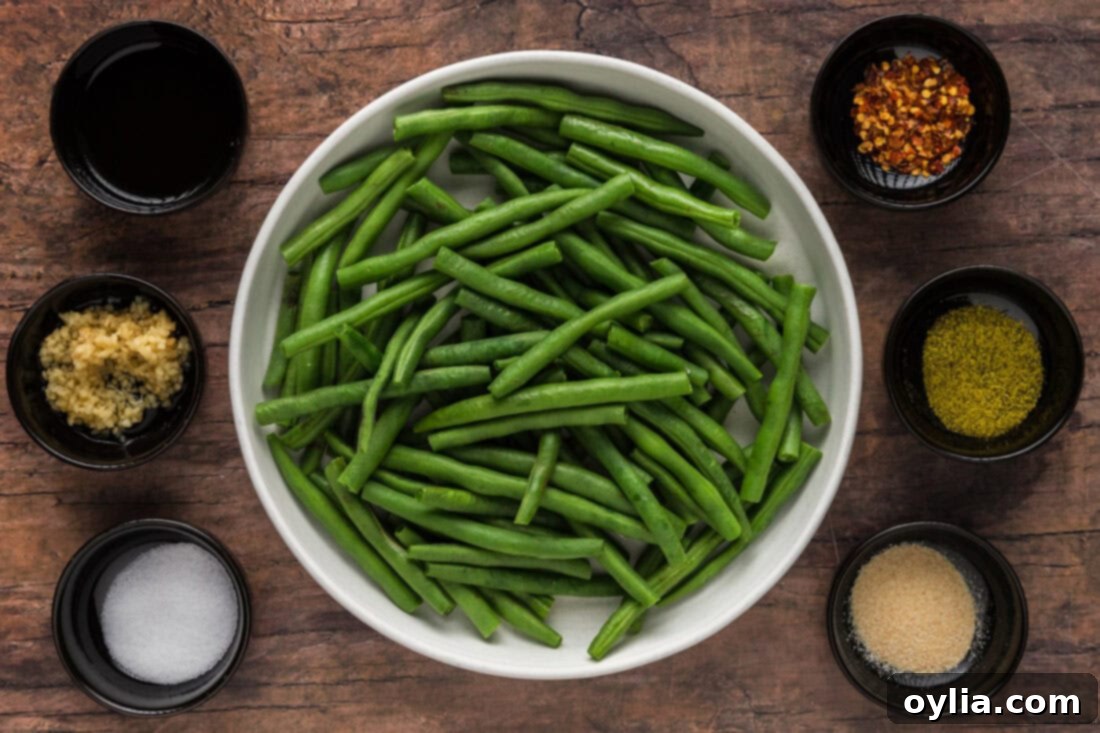
Ingredient Spotlight: Tips & Smart Substitutions
Understanding each ingredient helps you achieve the best results and confidently make adjustments. Here’s a closer look:
- Fresh Green Beans: The quality of your green beans truly makes a difference here. Select plump, firm beans with a vibrant green hue that snap crisply when bent. Avoid any that look dull, rubbery, or have visible blemishes. For a more elegant presentation, we prefer to keep our green beans long after trimming the ends. However, if you prefer, you can easily cut them into shorter, bite-sized pieces, which can also make them quicker to cook and easier to eat.
- Sesame Oil: This is a cornerstone ingredient for the recipe’s distinct flavor profile. Toasted sesame oil, in particular, delivers a deep, nutty, and highly aromatic essence that elevates the simple green beans to a new level. If you only have regular (un-toasted) sesame oil, it will still work but will offer a milder flavor. For those seeking a neutral flavor or without sesame oil on hand, olive oil or avocado oil can be used as a substitute, though the final taste will differ significantly.
- Minced Garlic: Freshly minced garlic is paramount for creating a robust and savory foundation. Its pungent aroma and sweet flavor, once sautéed, infuse the entire dish. While pre-minced garlic from a jar can be used for convenience, fresh garlic always provides a superior, more vibrant taste. Aim for a fine mince to ensure it cooks evenly and integrates well without overpowering the beans.
- Seasonings: Our carefully chosen blend of seasonings perfectly complements the green beans, garlic, and sesame oil.
- Salt: A fundamental flavor enhancer, salt helps draw out the natural sweetness of the green beans and harmonizes all the other flavors. Adjust the amount to your personal preference, keeping in mind that lemon pepper blends may also contain sodium.
- Onion Powder: This adds a foundational layer of savory onion flavor without the texture or sharpness of raw onion. It’s a subtle yet impactful addition that rounds out the spice profile.
- Lemon Pepper: Offering a bright, zesty, and subtly peppery kick, lemon pepper is a fantastic match for green beans. It provides a burst of freshness. If you don’t have lemon pepper, a squeeze of fresh lemon juice added at the very end of cooking, combined with a dash of black pepper, can serve as an effective substitute.
- Red Pepper Flakes: Completely optional, but highly recommended for those who enjoy a gentle warmth and a hint of spice. Red pepper flakes add an exciting dimension to the dish, balancing the richness of the sesame oil and the pungency of the garlic. Start with a small amount and increase to taste if you desire more heat.
Mastering Sautéed Green Beans: A Step-by-Step Guide
These step-by-step photos and detailed instructions are crafted to guide you visually through the process, ensuring you achieve perfect results. For a streamlined, printable version of this recipe, including all precise measurements and a concise instruction list, you can jump directly to the recipe card at the very bottom of this post.
- Prepare the Green Beans: Begin by washing your fresh green beans thoroughly under cool running water. Pat them dry with a clean kitchen towel or paper towels. Next, trim off the tough, woody stem ends. You can do this quickly by lining up several beans and slicing off the ends with a knife, or by simply snapping them off by hand.
- Heat the Sesame Oil: Place a large, heavy-bottomed skillet (a 10-inch or 12-inch skillet works perfectly for one pound of beans) over medium-high heat. Add the sesame oil to the pan and allow it to heat until it just begins to shimmer. This indicates the oil is hot enough to quickly sauté and infuse flavors without burning.
- Sauté the Garlic: Add the minced garlic to the hot sesame oil. Sauté for approximately one minute, stirring continuously with a spatula or spoon. Watch carefully to ensure the garlic doesn’t turn dark brown or burn, as burnt garlic can impart a bitter taste. You’re aiming for a fragrant, slightly softened garlic that releases its wonderful aroma.
- Introduce Green Beans and Coat: Promptly add the trimmed green beans into the skillet with the garlic and oil. Using tongs or a sturdy spatula, toss the green beans vigorously to ensure they are thoroughly coated with the aromatic sesame oil and garlic. This initial coating is crucial for even flavor distribution and helps prevent sticking.

- Season and Cook to Perfection: Sprinkle the green beans evenly with salt, onion powder, and lemon pepper. Toss them once more to ensure the seasonings cling to every bean. Continue cooking for 5-10 minutes, making sure to toss them frequently to prevent any part from scorching and to promote even cooking. The exact cooking time depends on your preferred level of doneness. For a delightful tender-crisp texture, cook for about 5-7 minutes. If you prefer them a bit softer, extend the cooking closer to 10 minutes. The beans should be bright green and slightly softened, but still retain a pleasant snap.

- Add Red Pepper Flakes (Optional): Once your green beans have reached the desired tenderness, sprinkle in red pepper flakes to taste. Toss for another minute or two, allowing the heat to gently activate the flakes and release their subtle spice. This final touch adds an extra layer of complexity. Serve your perfectly sautéed green beans immediately and enjoy the burst of fresh flavor!


Frequently Asked Questions & Expert Tips for Success
No, it’s absolutely not necessary to blanch your green beans before sautéing them for this recipe. Blanching, which involves briefly boiling and then chilling the beans, is often done to pre-cook them and set their vibrant color. However, when you sauté green beans directly in a hot skillet as outlined here, they achieve a perfectly tender-crisp texture and a beautiful color without the extra step. This method saves you time, an extra pot to clean, and simplifies the overall cooking process, making it ideal for quick, flavorful results.
Once your sautéed green beans have cooled completely, transfer them to an airtight container. They can be stored in the refrigerator for 3-4 days. To reheat, the best method is to warm them gently in a skillet over medium-low heat. You can add a very small amount of water or a tiny drizzle of oil to help them warm through without drying out. Toss them frequently until heated to your desired temperature. We do not recommend freezing sautéed green beans, as the thawing process often compromises their delicate texture, making them mushy rather than tender-crisp.
Sautéed green beans are incredibly versatile and welcome a variety of additional ingredients to enhance their flavor and texture. Feel free to experiment with:
- Crispy Bacon Bits: Cook some chopped bacon in the skillet before adding the green beans, then use the rendered fat for sautéing and sprinkle the cooked bacon over the finished dish.
- Slivered Almonds or Pecans: Toast these nuts lightly in the pan during the last minute of cooking, or sprinkle them over the top for an added crunch and nutty flavor.
- Finely Diced Shallots or Onions: Sauté these along with the garlic at the beginning for a deeper aromatic base.
- Fresh Herbs: A sprinkle of fresh parsley, chives, or dill after cooking can add a burst of freshness.
- Lemon Zest or a Splash of Vinegar: A touch of acidity, either from lemon zest or a drizzle of balsamic or red wine vinegar at the end, can brighten all the flavors.
- Grated Parmesan Cheese: For a savory, umami boost, sprinkle some finely grated Parmesan cheese over the hot beans before serving.
While fresh green beans undeniably yield the best texture and flavor for this sautéed recipe, you can use frozen green beans as an alternative if fresh are unavailable. The most crucial step when using frozen beans is to ensure they are completely thawed before cooking. You can quickly thaw them by submerging them (still in their bag) in a bowl of cold water, or by rinsing them under cold running water in a colander. Once thawed, it is absolutely essential to pat them thoroughly dry with paper towels. Any residual moisture will cause the beans to steam rather than sauté, preventing them from developing that desirable tender-crisp texture and slight caramelization. Once dry, proceed with the recipe instructions as usual.
Achieving that perfect tender-crisp texture is key to delicious sautéed green beans. Here are a few expert tips:
- Hot Skillet: Ensure your skillet is heated to medium-high before adding the beans. A hot pan promotes quick cooking and browning.
- Don’t Overcrowd: Cook in batches if you’re making a very large quantity. Overcrowding the pan lowers the temperature and causes the beans to steam rather than sauté, resulting in a softer texture.
- Frequent Tossing: Stir or toss the beans every minute or so. This ensures even cooking and prevents any single bean from scorching.
- Timely Removal: Pay attention to the cooking time and visual cues. The beans should be bright green and just starting to soften, but still have a firm bite. A quick taste test will confirm they’re perfect.
By following these tips, you’ll consistently achieve beautifully tender-crisp results!
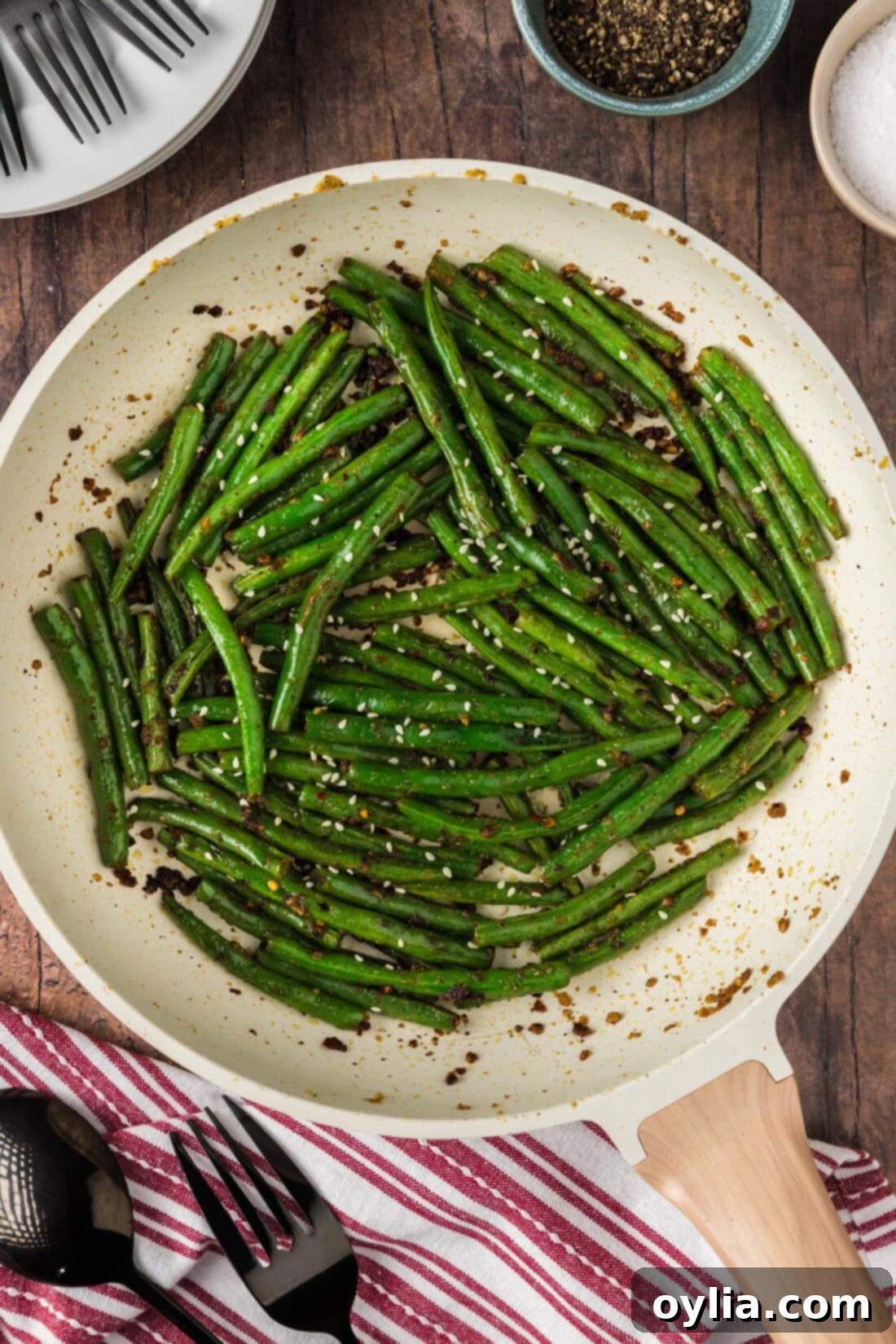
Perfect Pairings: What to Serve with Sautéed Green Beans
The delightful flavors of these sautéed green beans make them an incredibly versatile side dish that complements a vast array of main courses. Their savory, garlicky, and slightly spicy profile pairs wonderfully with almost any protein or vegetarian meal. Here are some serving suggestions to inspire your next culinary creation:
- Poultry: They are a fantastic match for classic roasted chicken, pan-seared turkey breast, or simple grilled chicken kebabs. The light and fresh flavor of the beans provides a lovely contrast to richer poultry dishes.
- Beef: A timeless accompaniment to a perfectly cooked steak (such as a ribeye, sirloin, or tenderloin), slow-cooked pot roast, or even hearty meatloaf.
- Pork: Excellent when served alongside juicy pork chops, a tender roasted pork loin, or even a savory glazed ham.
- Fish & Seafood: The bright, zesty notes of the green beans complement delicate fish like baked salmon, pan-seared cod, or grilled shrimp and scallops beautifully.
- Vegetarian Mains: For a complete vegetarian meal, pair them with a wholesome lentil loaf, a creamy mushroom risotto, or a flavorful cheesy pasta dish. They also make a great addition to grain bowls.
- Holiday Feasts: Simple enough for a quick weeknight dinner, yet elegant enough for holiday gatherings like Thanksgiving or Christmas, offering a fresh and lighter alternative to traditional heavy sides.
No matter the occasion or the main course, a generous serving of these quick and easy sautéed green beans is always a fantastic and flavorful choice that will impress your family and guests.
Explore More Delicious Green Bean Recipes
If you’re a true green bean enthusiast and eager to discover even more ways to prepare this versatile and nutritious vegetable, you’ve come to the right place! We offer a variety of recipes that showcase green beans in different cooking styles and for various culinary preferences. Expand your green bean repertoire with these exciting options:
- Garlic Green Beans
- Roasted Green Beans
- Air Fryer Green Beans
- Instant Pot Green Beans
I genuinely love spending time in the kitchen, creating new recipes, and sharing my culinary experiences with all of you! To ensure you never miss out on a delicious dish or helpful cooking tip, I offer a convenient newsletter delivered directly to your inbox every time a new recipe is posted. Simply subscribe here and start receiving your free daily recipes, kitchen inspiration, and more!
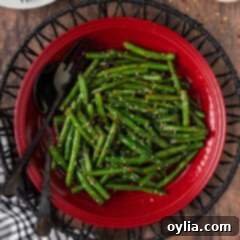
Sautéed Green Beans
No blanching, just your handy dandy skillet and 10 minutes of cook time is all it takes to make tender-crisp sautéed green beans.
IMPORTANT: There are often Frequently Asked Questions and Expert Tips within the blog post that you may find helpful. Simply scroll back up to read them!
Pin It
Rate It
Prevent your screen from going dark
Course: Side Dish
Cuisine: American
Servings: 4 servings
Total Time: 20 mins
Calories: 75
Author: Amanda Davis
Ingredients
- 1 pound fresh green beans
- 1 Tablespoon sesame oil
- 1 Tablespoon minced garlic
- 1 teaspoon salt
- 2 teaspoons onion powder
- 2 teaspoons lemon pepper
- Red pepper flakes, to taste
Equipment You’ll Need
- Large skillet
Before You Begin – Important Notes
- Choose plump fresh green beans that are free of blemishes. We prefer our green beans long as they look nicer for presentation. You can cut yours shorter if you like.
- Fresh green beans are truly best here, but in a pinch you can use frozen green beans. I would recommend letting them thaw first. You can thaw them quickly submerged (in a plastic bag) in a bowl of cold water. Or, simply place them in a colander and run them under cold water until thawed. Then, pat them dry and toss them in the skillet continuing with the recipe instructions.
Instructions
- Trim the ends off the green beans.
- Heat sesame oil in a skillet over medium-high heat until shimmering.
- Add garlic and sauté for one minute until fragrant.
- Add green beans and toss to coat with the oil and garlic.
- Sprinkle with salt, onion powder, and lemon pepper, tossing to coat. Cook for 5-10 minutes, tossing frequently so beans don’t scorch. Adjust cooking time for your desired tenderness.
- Season to taste with red pepper flakes and sauté for another minute or two. Serve immediately.
Expert Tips & FAQs (Key takeaways from above)
- Storage: Store cooled leftovers in an airtight container in the refrigerator for 3-4 days. Reheat in a skillet over medium-low heat. Do not freeze.
- Blanching: No blanching is required for this recipe; direct sautéing yields excellent results.
- Additions: Enhance flavor with chopped bacon, toasted nuts, shallots, or a squeeze of fresh lemon juice.
- Frozen Beans: If using frozen, thaw completely and pat very dry before cooking to prevent steaming.
- Tender-Crisp: Use a hot skillet, don’t overcrowd, and toss frequently for perfect texture.
Nutrition Information
Serving: 1 serving | Calories: 75kcal | Carbohydrates: 10g | Protein: 2g | Fat: 4g | Saturated Fat: 1g | Polyunsaturated Fat: 2g | Monounsaturated Fat: 1g | Sodium: 589mg | Potassium: 271mg | Fiber: 4g | Sugar: 4g | Vitamin A: 788IU | Vitamin C: 15mg | Calcium: 54mg | Iron: 1mg
Tried this Recipe? Pin it for Later!
Follow on Pinterest @AmandasCookin or tag #AmandasCookin!
The recipes on this blog are carefully tested using a conventional gas oven and a gas stovetop to ensure consistent results. It’s important to be aware that some ovens, particularly as they age, may cook and bake inconsistently. Using an inexpensive oven thermometer can be a great way to confirm that your oven is truly heating to the proper temperature. If you utilize a toaster oven or a countertop oven, please keep in mind that these appliances may not distribute heat identically to a conventional full-sized oven, and you might need to adjust your cooking or baking times accordingly. For baking recipes where ingredient measurements are provided by weight, we highly recommend adhering to those specifications, as using volumetric cups can lead to different outcomes, and we cannot guarantee success with such substitutions.
